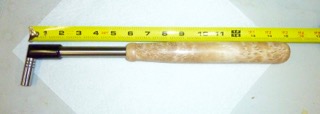I've been through a number of levers. The experimentation was driven by two main parameters...ie, it had to suite my body's innate proprioceptive hardware, and it had to allow me, given my weedy build, with poor muscle tone in the torso, to apply adequate torque to the lever/pin with a fine degree of control.
The first time I touched a Faulk lever early on, I had an instant proprioceptive connection to the lever and pin. Interestingly, I didn't buy my Faulk lever until years later, after I gone through a Jahn, Goss, and Levitan's C lever. Using these levers really taught me how much the pin is flexed in using any traditional lever...The the C lever really gives one an education in this department...as it allows you to eliminate bending flex, if you choose. The C lever, though very helpful in learning to read the forces involved, was somewhat frustrating in its internal flex. The tubular design stored too much flex energy for final movements for me. Also I found the C lever very hard on my mid back.
So, combining the ability to read the front segment conditions that the C Lever taught me, having experienced the extreme flex that a 20 deg head (had a 20 deg head on the Goss) imparts to a system, and wanting a longer lever to help my poor musculature, led me to ask Charles Faulk to make me a custom lever which he did.
So I got the really stiff head connection that John mentioned, really stiff and light tube, and long slender handle for wide arc levered advantage. Then learned to use that leverage to manipulate the flex in a way that works with this lever really well. No arm or torso movements are involved, on grands or uprights, and no slapping. Rather, since the slender handle is close to the plate struts or upright's case, with my hand alone, levering off the plate or case top, or pins, or whatever I can get a hold of, the hand gently levers the handle with precision that escaped me with large muscle movements.

I recently switched it out from a 10 deg head to a 5 deg, with a BKB #3 tip. Because of the slender handle, I have surprisingly had plate clearance on everything I've tuned...I expected interference with the low angle head
I think the bottom line is, the ideal lever is the lever that fits one's particular innate proprioceptive and muscular hardware, the one that lets you read what's going on in the front segment, in terms of flex and friction. Stiffness, lightness and lever length work for me.
------------------------------
Jim Ialeggio
grandpianosolutions.com
Shirley, MA
978 425-9026
------------------------------
Original Message:
Sent: 11-17-2017 07:27
From: John Formsma
Subject: Tuning Hammer Articles
What separates the lesser from the better is a rigid connection between head and shaft, and also a stiff shaft with minimal flex.
Lots of great levers available. I started with a Hale extension lever, then went to a Jahn extension lever, then went to the first Fujan (aluminum), then a Fujan carbon fiber. Right now I have the Fujan carbon fiber that I use for verticals, and a homemade lever that I prefer on grands. I also occasionally use a Levitan C hammer for some grands, but I much prefer the traditional levers.
The Fujan is light and very stiff, and does great for my karate chop style for uprights. My homemade lever is heavy and stiff, but I like the length and feel of it when tuning grands (mostly smooth pull method). It has a 10º Jahn head and a stainless steel shaft with a pool cue ball epoxied onto one end.
The Reyburn Rigid Lever has my attention and I might give that a try soon.
I've also used the Reyburn CyberHammer for verticals and grands, but prefer a traditional lever. Which reminds me...I have a CyberHammer for verticals that I'd like to sell if anyone's interested. It's not the newest and lightest but in good shape.
------------------------------
John Formsma, RPT
New Albany MS
Original Message:
Sent: 11-16-2017 22:15
From: Benjamin Sanchez
Subject: Tuning Hammer Articles
Hi Larry,
If my research is correct, it would indicate that the more an examinee is used to their lever, the more likely they are to pass, regardless of what type their lever is. Of course, the lever has to be of some quality, as I've never heard of anyone using one of those "student levers" to pass the exam - although I'm sure it has been done.
Obviously, there is a raise in popularity of the carbon fiber tuning levers. However, I'm finding that a good portion of tuners still use an extension lever.
As far as my research goes, I'm trying to find out more about the make and design of tuning levers, and what separates a poor lever from a good one, and a good one from a great one, etc.
------------------------------
Benjamin Sanchez
Professional Piano Services
(805)315-8050
www.professional-piano-services.com
BenPianoPro@comcast.net
Original Message:
Sent: 11-16-2017 21:44
From: Larry Messerly
Subject: Tuning Hammer Articles
It would probably only be anecdotal but which levers used are more successful at passing the tuning exam.
------------------------------
Larry Messerly, RPT
Bringing Harmony to Homes
www.lacrossepianotuning.com
ljmesserly@gmail.com
928-899-7292
Original Message:
Sent: 11-16-2017 18:56
From: Benjamin Sanchez
Subject: Tuning Hammer Articles
Hello all,
I plan on getting back to my research on tuning hammers soon, and was wondering if you knew of any articles that have appeared in the Journal over the years.
Thanks,
------------------------------
Benjamin Sanchez
Professional Piano Services
(805)315-8050
www.professional-piano-services.com
BenPianoPro@comcast.net
------------------------------